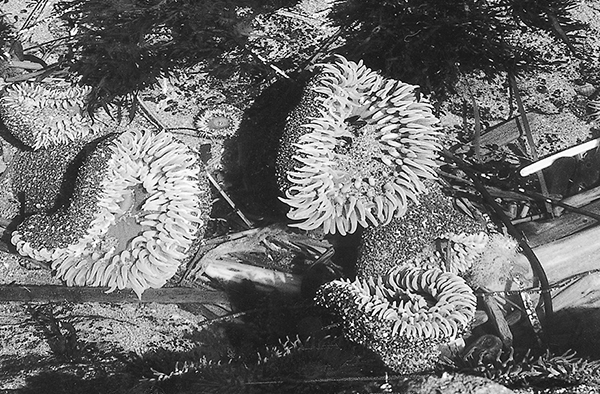
Sea anemones in an Olympic coastline tidepool
The Olympic Coastline
The wild and rugged Olympic coast is the site of ceaseless change. Wave action weathers arches and sea stacks from resistant blocks of sandstone, then slowly abrades them down to nothing. The fractured rock of the coves is constantly slumping onto the beach, then is carried away by the tides. Flood-gorged rivers discharge great plumes of silt and debris into the ocean, forming long spits at their mouths. Enormous logs are washed out to sea by these rivers, and these are stripped and polished by the surf and then cast up on the beach. The incessant pounding of the waves, as well as the periodic tempests of wintertime, are constantly at work tearing down the coastline and building it anew.
This environment of endless upheaval is also the site of one of the most diverse biological communities in the Pacific Northwest. Tidepools harbor an almost infinite array of invertebrate life amid a lush growth of aquatic plants. Gulls, mergansers, ospreys, and bald eagles wheel on the ocean breezes, while oystercatchers and sandpipers patrol the beaches and rocks. The offshore islands teem with marine mammals, featuring sea otters, gray whales, orcas, harbor seals, and the endangered Steller’s sea lion. Such a bounty of marine life forms the economic backbone of the coastal Indian villages that have stood here from time immemorial.
Most of the coastline can be hiked, although Quateata and Teahwhit Head are completely impassable, and the Queets, Hoh, and Quillayute Rivers are always too deep to ford. A tide table is a must because heavy surf renders most of the headlands impassable at high tide. Tide tables are posted at most trailheads, and free copies are usually offered as well. Avoid hiking on an incoming tide, and use common sense at all times. Changing weather patterns can result in higher tides than expected, especially when a storm is brewing. In addition the surf often tosses huge (and deadly) logs around like matchsticks, and in many cases these surf logs are waterlogged and invisible beneath the waves. Do not swim in the surf of unprotected beaches; venture into the water only in protected areas that have little wave action. NOTE: The water is extremely cold, even in summer.
Developed areas near the coast can be found at Ozette Lake, Mora, and Kalaloch. Kalaloch has its own lodge, and campgrounds and ranger stations can be found at all of these locations. Ozette Lake is a popular destination, and its campground is often full. Call ahead to ask if space is available because there are few alternatives for camping elsewhere in the area. Clallam Bay, Forks, and, to a lesser extent, Kalaloch offer groceries and other supplies.

Sea anemones in an Olympic coastline tidepool